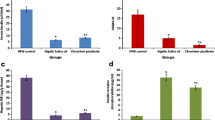Abstract
This study was designed to evaluate the effect of administration of chromium-enriched Grifola frondosa (CEGF) in insulin-resistant sucrose-fed mice. Mice were randomly assigned to be unsupplemented (S group) or to receive oral CEGF at a dose of 0.5, 1.0, 2.0, 3.0, 4.0, and 5.0 mg/kg per day chromium. A control group (C) did not consume sucrose and was not supplemented. Sucrose-fed mice had an elevated serum insulin concentration compared with controls and this was significantly lower in sucrose-fed mice that received CEGF (4.0 and 5.0 mg/kg per day chromium), which did not differ from controls. Impaired glucose tolerance in sucrose-fed mice, evidenced by the poor glucose disposal rate following an intraperitoneal glucose tolerance test, was significantly improved in mice receiving CEGF. CEGF is essentially nontoxic at the dose of 4.0 and 5.0 mg/kg per day. These results indicate that CEGF may have potential beneficial effects in insulin-resistant prediabetic conditions.


Similar content being viewed by others
References
Lozak A, Soltyk K, Stapczuk PO et al (2002) Determination of selected trace elements in herbs and their infusions. Sci Total Environ 289:33–40.
Anderson RA (1997) Nutritional factors influencing the glucose/insulin system: chromium. J Am Coll Nutr 16:404–410.
Vincent JB. (2000) The biochemistry of chromium. J Nutr. 130:715–8.
Anderson RA. (1992) Chromium, glucose tolerance, and diabetes. Biol Trace Elem Res. 32:19–24.
Wang H, Kruszewski A, Brautigan DL. (2005;) Cellular chromium enhances activation of insulin receptor kinase. Biochemistry. 44:8167–75.
Zhitkovich, A., (2005) Importance of chromium—DNA adducts in mutagenicity and toxicity of chromium (VI). Chem. Res. Toxicol. 18: 3–9.
Reynolds, M., Stoddard, L., Bespalov, I. et al (2007) Ascorbate acts as a highly potent inducer of chromate mutagenesis and clastogenesis: linkage to DNA breaks in G2 phase by mismatch repair. Nucleic Acids Res. 35: 465–476.
Dong F, Kandadi MR, Ren J (2008) Chromium (d-phenylalanine)3 supplementation alters glucose disposal, insulin signaling, and glucose transporter-4 membrane translocation in insulin-resistant mice. J Nutr. 138:1846–51
Kim, D.H., Yang, B.K., Jeong, S.C. et al, (2001) Production of a hypoglycemic, extracellular polysaccharide from the submerged culture of the mushroom, Phellinus linteus. Biotechnol. Lett. 23:513–517.
Keiko, K., Hisao, A., Hiroaki. N. (1994) Anti-diabetic activity present in the fruit body of Grifola frondosa (Maitake). Biol. Pharm. Bull. 17:1106–1110.
Kalac P, Niznamska M, Bevilaqua D. (1996) Concentrations of mercury, copper, cadmium and lead in fruiting bodies of edible mushrooms in the vicinity of a mercury smelter and a copper smelter. Sci Total Enxiron. 177: 251–258.
Han C, Cui B, Wang Y. (2008) Vanadium uptake by biomass of Coprinus comatus and their effect on hyperglycemic mice. Biol Trace Elem Res. 1241:35–9.
Han C, Liu T. (2009) A comparison of hypoglycemic activity of three species of basidiomycetes rich in vanadium. Biol Trace Elem Res. 127:177–82.
Beran M, Stahl R, Beran M Jr (1995) Glycaemic activity of chromium (III)-b-nicotinamide adenine dinucleotide phosphate complex and its presence in yeast extracts. Analyst 120:979–981
Davis CM, Vincent JB (1997) Chromium in carbohydrate and lipid metabolism. J Biol Inorg Chem 2:675–679.
Dutta K, Podolin DA, Davidson MB, et al (2001) Cardiomyocyte dysfunction in sucrose-fed rats is associated with insulin resistance. Diabetes. 50:1186–92.
Bagchi D, Stohs SJ, Downs BW, et al (2002) Cytotoxicity and oxidative mechanisms of different forms of chromium. Toxicology. 180:5–22.
Davis CM, Vincent JB. (1997) Chromium oligopeptide activates insulin receptor tyrosine kinase activity. Biochemistry. 36:4382–5.
Wang ZQ, Zhang XH, Russell JC, et al (2006) Chromium picolinate enhances skeletal muscle cellular insulin signaling in vivo in obese, insulin-resistant JCR:LA-cp rats. J Nutr. 136:415–20.
Chen G, Liu P, Pattar GR, et al (2006)Chromium activates glucose transporter 4 trafficking and enhances insulin-stimulated glucose transport in 3T3-L1 adipocytes via a cholesterol-dependent mechanism. Mol Endocrinol. 20:857–70.
Acknowledgment
This research was supported by projects for Young Scientist from IPCAS (08CX043004) and a NNSF grant (30800301).
Author information
Authors and Affiliations
Corresponding author
Rights and permissions
About this article
Cite this article
Xu, Q., Guo, J. Activity and Toxicity of Cr(III)-Enriched Grifola frondosa in Insulin-Resistant Mice. Biol Trace Elem Res 131, 271–277 (2009). https://doi.org/10.1007/s12011-009-8364-3
Received:
Accepted:
Published:
Issue Date:
DOI: https://doi.org/10.1007/s12011-009-8364-3




